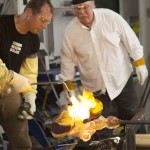
The world’s best glass museum has teamed up with the leading glass innovator to launch a new residency program that supports artists in adapting specialty glass materials for the creation of new work. The Corning Museum of Glass is collaborating with Corning Incorporated to provide a new Specialty Glass Residency, and the first artist selected for this unique collaboration is American sculptor Albert Paley.
Corning Incorporated, which has developed and patented more than 150 specialty glass formulations, is providing the resident artist with access to specialty glass, as well as access to staff with technical expertise in glass formulation, melting, and forming. The resident artist will also work closely with the Museum’s glassmakers, curators, and other staff to better understand glass and its historical and artistic contexts.
Paley, who is best known for his large-scale works in metal, has chosen to work with two Corning glasses. In August, he began exploring furnace-working and casting of Corning Code 7056, a borosilicate glass that was engineered to bond tightly to a metal alloy called Kovar. Corning 7056 is used industrially in special electronic circuit packages that need the durability of the metal, and the transparency of glass, with a perfect, air-tight seal between the two. Over the course of the year-long residency, Paley will also investigate high-purity fused silica (HPFS). HPFS can be aggressively shaped and joined with a torch, similar to how Paley works metal.
The residency is less about creating a final body of work, and more about exploration, both for the artists and the material scientists. “We are dedicated to innovation and experimentation with glass, and have a long history of collaborating with artists” says Dr. David Morse, executive vice president and chief technology officer of Corning Incorporated, and one of the Museum’s newest board members. “We look forward to continuing this tradition and are eager to see how artists will use these specialty materials – and perhaps even add to our understanding of their capabilities and adaptability.”
Dr. Glen (Jane) Cook, a senior research associate at Corning Incorporated, is the scientific advisor overseeing the residency program.
“Artists and scientists share a passion for discovery, and, in the early stages of their explorations in new areas, actually use very similar methods: using intuition and experience to set up situations and interactions that they keenly observe and consider,” he says. “It is from those observations new works are created according to the methods of their professions. In this Residency, I can create an environment for artists and scientist to come together and share those moments of discovery, learn from them, and create something new to the world.”
This appeals to Paley as well. “To me, exploration is primary,” he says. “New materials open up new possibilities.”
The first glassmaking sessions took place at Sullivan Park, Corning’s research facility in Corning. Technicians and material scientists from Corning Incorporated and Museum glassmakers joined Paley in the lab. They melted and shaped and dripped the 7056 glass and the metal together in various forms to see what it could do. After examining the resulting forms, Paley began to sketch ideas and, in the next session, the team began fusing abstract forms in Kovar shaped by Paley with the 7056 glass.
Paley has explored using glass and metal together in his sculpture, and he likes the way the materials play off of each other. “It’s a sympathy of opposites,” he says. “You can understand certain aspects of the iron and vice versa.”
However, this was the first time Paley – and perhaps any artist – has actually fused the two materials together.
“It’s difficult enough to find different glasses that are compatible,” says Museum glassmaker Eric Meek. “The idea of fusing glass with another material is something almost every glassmaker dreams of, but usually is totally off the table as an option. We did something I don’t believe has been done by an artist in the 3,500-year history of glassmaking – we fused iron with glass.”
“To engage with materials and processes that allow you to experience new realities, that’s where the real breakthroughs come,” says Paley.
Paley will work on the Corning campus through June 30, 2015. Residencies in 2015 will be by invitation only.



1 comment » Write a comment